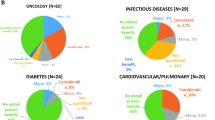Abstract
The private biomedical research industry has brought significant benefits to patients and has been a major factor in the transformation of the course and treatment of disease over the past half century. It is estimated that over 90% of the medicines in use today have been discovered or developed by the industry. Successful medicines bring revenues to the companies who research and develop them through long-term at-risk investment; the ensuing returns through medicine sales are a key element in sustaining a virtuous circle in the traditional drug research and development (R&D) model. However, late-stage attrition, along with increasing development costs, are now challenging companies and the current R&D model. As a consequence, biopharmaceutical companies are under ever increasing pressure to develop new R&D models.
This article describes the current status of large pharma R&D and how it goes about developing new drugs. It analyses some of the current key industry strategic trends and themes that may govern whether the current business model succeeds and continues to be the engine house of delivery for new medicines for society, or whether key changes are required to maximise R&D efficiency and to deliver regulatory approvable and medically required new drugs.





Similar content being viewed by others
References
PriceWaterhouseCooper. Pharma 2020: the vision. Which path will you take? [online]. Available from URL: http://www.pwc.com/extweb/pwcpublications.nsf/docid/91BF330647FFA402852572F2005ECC22 [Accessed 2007 Aug 20]
Lahana R. How many leads from HTS? Drug Discov Today 1999; 4: 447–8
Brown P. Has R&D failed the pharmaceutical industry? [letter]. Scrip 1994 Jul/Aug, 3–4
Healey D. The psychopharmacologists III. London: Arnold, 2000
Horrobin DF. Modern biomedical research: an internally self-consistent universe with little contact with medical reality? Nat Rev Drug Discov 2003; 2: 151–4
Samson M, Libert F, Doranz BJ, et al. Resistance to HIV-1 infection in caucasian individuals bearing mutant alleles of the CCR-5 chemokine receptor gene. Nature 1996 Aug 22; 382 (6593): 722–5
Dorr P, Westby M, Dobbs S, et al. Maraviroc (UK-427,857), a potent, orally bioavailable, and selective small-molecule inhibitor of chemokine receptor CCR5 with broad-spectrum anti-human immunodeficiency virus type 1 activity. Antimicrob Agents Chemother 2005 Nov; 49 (11): 4721–32
Buchdunger E, Zimmermann J, Mett H, et al. Inhibition of the Abl protein-tyrosine kinase in vitro and in vivo by a 2-phenylaminopyrimidine derivative. Cancer Res 1996; 56: 100–4
Brown D, Superti-Furga G. Rediscovering the sweet spot in drug discovery. Drug Discov Today 2003; 8: 1067–77
Sams-Dodd F. Target-based drug discovery: is something wrong? Drug Discov Today 2005; 10: 139–47
Hopkins AL, Groom CR. Target analysis: a priori assessment of druggability. Ernst Schering Res Found Workshop 2003; (42): 11–7
Hajduk PJ, Huth JR, Fesik SW. Druggability Indices for protein targets derived from NMR-based screening data. J Med Chem 2005; 48: 2518–25
Hopkins AL, Groom CR. The druggable genome. Nat Rev Drug Discov 2002; 1: 727–30
Payne DJ, Gwynn MN, Holmes DJ, et al. Drugs for bad bugs: confronting the challenges of antibacterial discovery. Nat Rev Drug Discov 2007; 6: 29–40
Kubinyi H. Chemogenomics in drug discovery. Ernst Schering Res Found Work-shop 2006; 58: 1–19
Paolini GV, Shapland RHB, van Hoorn WP, et al. Global mapping of pharmacological space. nature biotech. In Press (2006)
Kitano H. A robustness-based approach to systems-oriented drug design. Nat Rev Drug Discov 2007; 6: 202–10
Roth BL, Sheffler DJ, Kroeze WK. Magic shotguns versus magic bullets: selectively non-selective drugs for mood disorders and schizophrenia. Nat Rev Drug Discov 2004; 3: 353–9
Zambrowicz BP, Sands AT. Modeling drug action in the mouse with knockouts and RNA interference. Drug Discov Today: TARGETS 2004 Oct; 3 (5): 198–207
Barabasi AL, Oltvai ZN. Network biology: understanding the cell’s functional organization. Nat Rev Genet 2004; 5: 101–13
Kaelin WGJ. The concept of synthetic lethality in the context of anticancer therapy. Nat Rev Cancer 2005; 5: 689–98
Stockwell BR. Exploring biology with small organic molecules. Nature 2004; 432: 846–54
Borisy AA, Elliott PJ, Hurst NW, et al. Systematic discovery of multicomponent therapeutics. Proc Natl Acad Sci U S A 2003; 100: 7977–782
Morphy R, Kay C, Rankovic Z. From magic bullets to designed multiple ligands. Drug Discov Today 2004; 9: 641–51
Keiser MJ, Roth BL, Armbruster BN, et al. Relating protein pharmacology by ligand chemistry. Nat Biotechnol 2007; 25: 197–206
R&D General Metrics Study from 1998 to 2005. Pharmaceutical Benchmark Forum. Chicago (IL): KMR Group, 2006
CMR International. 2006/7 Pharmaceutical R&D factbook. Epsom: CMR International, 2006
O’Connell DP, Roblin DR. Translational research in the pharmaceutical industry. Drug Discov Today 2006; 11: 833–8
Buckman S, Huang S-M, Murphy S. Medical product development and regulatory science for the 21st century: the critical path vision and its impact on health care. Clin Pharmacol Ther 2007; 81: 141–4
Fraser HE, Drayton S, Wang AE. Delay no more: improve patient recruitment and reduce time to market in the pharmaceutical industry. IBM Institute for Business Value. 2003 [online]. Available from URL: http://www-935.ibm.com/services/us/imc/pdf/ge510-3320-02.pdf [Accessed 2007 Jul 16]
Bungay S, Roblin DR, Slavin D. Taking command. Pharmaceutical Executive Europe 2006 Nov 1; 39–43 [online]. Available from URL: http://www.pharmexeceurope.com/europharmexec/article/articleDetail.jsp?.id=387075 [Accessed 2007 Jul 16]
Acknowledgements
The authors are all employees of Pfizer Inc. and own stock options in the company. The views in this article are the personal views of the authors and should not be construed as those of Pfizer.
No sources of funding were used to assist in the preparation of this review.
Author information
Authors and Affiliations
Corresponding author
Rights and permissions
About this article
Cite this article
O’Connell, D., Hopkins, A. & Roblin, D. Is it Time to Revisit the Current R&D Model?. Int J Pharm Med 21, 339–345 (2007). https://doi.org/10.2165/00124363-200721050-00004
Published:
Issue Date:
DOI: https://doi.org/10.2165/00124363-200721050-00004




